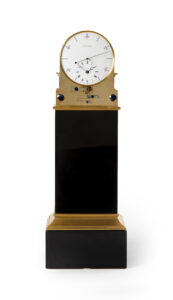MYSTERY CLOCK by Robert Houdin A Paris Ca. 1850 France
M&R81
MYSTERY CLOCK
Designed by Robert Houdin A Paris
Marked: Depose A.C. Paris 4173
Circa 1850
France
Movement
The spring-driven movement has an anchor escapement with adjustable hairspring balance and is mounted in the base of the case. The movement is wound at the bottom. The hands can also be adjusted here (‘Aiguilles’). The plate is marked Depose A.C. Paris and numbered 4173.
Dial
The arched glass dial, set in a moulded nickel-plated brass frame consists of three glass sheets. A chapter ring with cream-painted Arabic hour numerals and strokes for the minutes is painted on the front bevelled glass panel. The pierced hands in the centre are attached to the front glass sheet. The middle glass sheet, driven by an arm from the movement in the base, makes a tiny rotating movement, like a crankshaft, and thus drives the hands. The motion work (transmission between the hour and minute hands) is also located in the centre. This is an extremely delicate gear mechanism and therefore the hands should only be moved at the bottom. The rear glass plate serves as protection.
Case
The movement is housed in a black marble base. The superstructure of the case with dial is made of nickel-plated brass. The motion work is not visible through the glass of the arched dial. That is why this timepiece is called a mystery clock. In this case, the hands appear to rotate on the glass dial without any drive. It is remarkable that even today this clock still arouses wonder among those who see it for the first time. This demonstrates the genius of its designer Jean-Eugène Robert Houdin.
Note
Always adjust the hands at the bottom and NEVER touch the hands themselves.
Duration: 1 week
Height: 37 cm.
Width: 17.5 cm.
Depth: 11 cm.
Literature
– Derek Roberts, Mystery, Novelty & Fantasy clocks, Chapter 19, pp. 230-231.
– Klaus Maurice, Antique clocks/Schöne Uhren, pages 110 and 111.
– Herve Chayette, July 4, 1989, pages 54 and 55.
– Tardy, Dictionnaire des Horlogers Français, Paris, 1971, p. 300.
The maker Jean-Eugène Robert Houdin was born in Blois in 1805, the son of a watchmaker. He was both a watchmaker and a famous magician. From 1845 to 1852 he had his own theatre in the Palais Royal in Paris, where he organised ‘Soirées fantastiques’. For this he built various mechanisms to perform his tricks. He was one of the first to use hydraulic, magnetic and electrical effects for his tricks. Many of his inventions were patented. In 1830 he married the daughter of watchmaker Jacques-François Houdin (1783-1860) and took his father-in-law’s name because he greatly admired him. In the ‘Moniteur Universel’ of June 6, 1839, ‘La Pendule Mystérieuse’ was mentioned as a notable object at an exhibition of French products in Paris. There are different versions of ‘La Pendule Mystérieuse’. Houdin died in Saint-Gervais in 1871.














